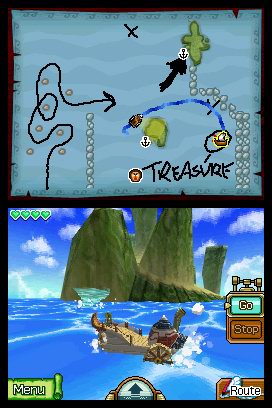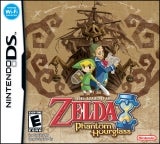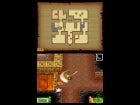I have no memory before this island...
Set as a direct sequel to Wind Waker, Phantom Hourglass recounts the story so far in the first of many cinematics. These sequences are all nicely done, and give you a real chance to appreciate how well the cel-shaded art style of Wind Waker works on the 3D-challanged DS hardware, with sharp colors and crisp animation. Play proceeds with the action on the lower screen and the map on the upper.

Controlling Link is done solely through stylus input. As he moves around the world, you simply place the stylus where you want him to go and he will make a bee-line for it. The closer the spot is to Link, the slower he'll go. If you want to carefully tread through traps, you'll be holding the stylus right by Link to tip-toe past the flames, spikes or whatnot. If you want to just run through a map and get somewhere, your stylus will probably be at the edge of the screen to send Link off at full speed.
To attack, just tap an enemy within range and Link will stab at them. You can also slash (with the stylus) between Link and an enemy for a slash attack, and spin-attack by drawing a quick circle around Link. A small circle on the edge of the screen will send you somersaulting to that edge. Unfortunately, these key commands, the bread and butter of combat, aren't as reliable as they should be.
Since the DS interprets your stylus inputs for you, all too often one input will become another command. Somersaulting is the worst offender. Even with practice, far too often you'll end up slashing instead of rolling, making the move too unreliable for combat. Frustration will mount when Link idly steps over a ledge to fall instead of making an easy jump, or when you die in a boss fight because instead of attacking the boss you've tapped on, Link takes a stutter-step towards it.
The frustration is moderated by a very approachable difficulty curve. This isn't a polite way of saying "easy," although regular gamers will doubtlessly find Phantom Hourglass an unchallenging experience. Hearts are abundant, things move at speeds that are easy to track with the stylus, you begin with the ability to hold as many rupees as you like, and even if you die, you'll find you haven't lost too much progress. Instead, combat, puzzles, and boss fights are all crafted to place the emphasis on satisfying problem solving and exploration. The difficulty is perfect; Nintendo has crafted a Zelda games that people who have played nothing but Brain Age will be able to finish, but series fans will be able to dive into happily.





 Outstanding!
Outstanding!


